
The Star Trek Customizable Card Game is an out-of-print collectible card game based on the Star Trek universe. The name is commonly abbreviated as STCCG or ST:CCG. It was first introduced in 1994 by Decipher, Inc., under the name Star Trek: The Next Generation Customizable Card Game. The game now has two distinct editions, though both forms of the game have many common elements.

A Game of Thrones: The Card Game is an out-of-print collectible card game produced by Fantasy Flight Games. It is based on A Song of Ice and Fire, a series of novels written by George R. R. Martin. The first set was Westeros Edition and was released in August 2002. It has since won two Origins Awards. The game's primary designer is Eric Lang, the lead developer is Nate French, with Damon Stone serving as associate designer.
Vampire: The Eternal Struggle is a multiplayer collectible card game published by Wizards of the Coast (1994-1996), then White Wolf Publishing (1996-2010) and after several years of hiatus, by Black Chantry Productions (2018-present). It is set in the World of Darkness and is based on the Vampire: The Masquerade roleplaying game.
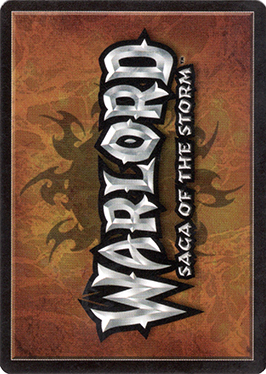
Warlord: Saga of the Storm is a collectible card game designed by Kevin Millard and David Williams. It was produced by Alderac Entertainment Group since its introduction in April 2001 until January 2008, when they announced they were ceasing its production. In place of AEG, German company Phoenix Interactive has licensed the rights to produce the game and printed their first set, Fourth Edition, in July 2008. The longer official name is almost always shortened to Warlord and the subtitle "Saga of the Storm" is often used informally to refer to the original base set of cards. The game is unrelated to an earlier, similarly named CCG, Warlords.

Call of Cthulhu: The Card Game is an out-of-print card game produced and marketed by Fantasy Flight Games. It is based on Chaosium's Call of Cthulhu role-playing game, the writings of H. P. Lovecraft, and other Cthulhu Mythos fiction. In 2008, Fantasy Flight moved the game over to its Living Card Game (LCG) format, which retains the deck-building aspect of collectible card games, but without the random distribution.
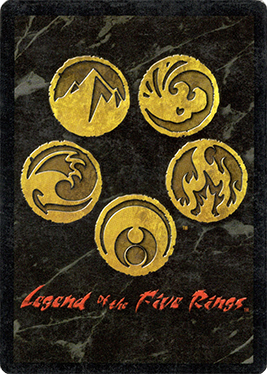
Legend of the Five Rings (L5R) is an out-of-print collectible card game created by a joint venture featuring Alderac Entertainment Group and ISOMEDIA in 1995 and published until 2015, when it was announced that the game would be discontinued for a rules-incompatible successor that will be part of Fantasy Flight Games' Living Card Game line. L5R takes place in the fictional empire of Rokugan from the Legend of the Five Rings setting, where several clans and factions vie for domination over the empire.

Middle-earth Collectible Card Game (MECCG) is an out-of-print collectible card game released by Iron Crown Enterprises in late 1995. It is the first CCG based on J.R.R. Tolkien's fictional universe of Middle-earth, with added content from ICE's Middle-earth Role Playing Game.

Rage is an out-of-print collectible card game originally published by White Wolf in May 1995 based on the role-playing game Werewolf: The Apocalypse. The game is based around packs of werewolves battling each other and various evil monsters while trying to save the world.
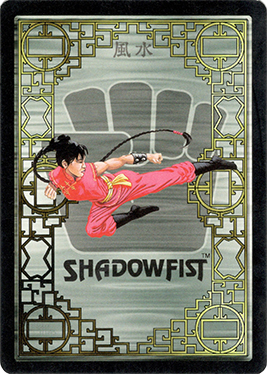
Shadowfist was created by Robin Laws and Jose Garcia. It was released in June 1995 as a collectible card game (CCG), but was shifted to a fixed distribution of cards as of 2013. It shares the same background as the Feng Shui, a role-playing game created by Laws and Garcia and released the following year. In September 2018 ownership of Shadowfist switched to Vetusta Games.
The Universal Fighting System (UFS), rebranded as UniVersus in 2021, is a collectible card game published by UVS Games. Games of UFS represent a fight between two characters in hand-to-hand combat. Characters are drawn from original properties as well as a number of licensed ones, such as Mega Man, Street Fighter, The King of Fighters XIII and Darkstalkers. The sets are cross-compatible – cards from multiple licenses can be included in the same deck, and characters from different universes may face each other in a match.
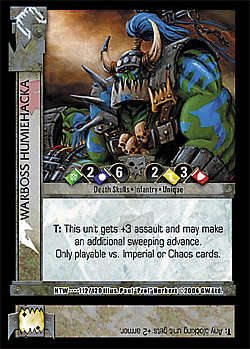
Dark Millennium is an out-of-print collectible card game. It's the successor to the Horus Heresy and set in the fictional Warhammer 40,000 universe. The base card set was launched in October 2005 by Sabertooth Games.

The Robotech Collectible Card Game (CCG) is an out-of-print collectible card game produced by Hero Factory that is set against the science fiction backdrop of Robotech. Cards are based on characters and mecha from this popular anime. After a limited public beta testing period, the game debuted at Anime Expo in 2006.
Gundam War: Mobile Suit Gundam the Card Game also known simply as Gundam War is an out-of-print collectible card game based on the Gundam anime series produced by Bandai. Players can simulate battles in the anime series. The game is designed for 2 players, though there may be different fan-created multiplayer rules. This game is sometimes confused with the Gundam M.S. War Trading Card Game, since both are published by Bandai and are based on the Gundam series.

Dune is an out-of-print collectible card game produced by Last Unicorn Games and Five Rings Publishing Group, and later Wizards of the Coast. Set in the Dune universe based on the books written by Frank Herbert, the game pits two or more players against each other, each in control of a minor house vying for entry in the Landsraad.

Battlestar Galactica Collectible Card Game is an out-of-print collectible card game based on the Battlestar Galactica science fiction media franchise. The game, published by WizKids, saw first release in May 2006 and was officially canceled in March 2007.

Enemy in Sight is a card game for 2–8 players published by Avalon Hill in 1988 that simulates naval warfare in the Age of Sail.
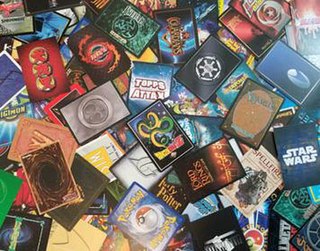
A collectible card game (CCG), also called a trading card game (TCG) among other names, is a type of card game that mixes strategic deck building elements with features of trading cards. It was introduced with Magic: The Gathering in 1993.
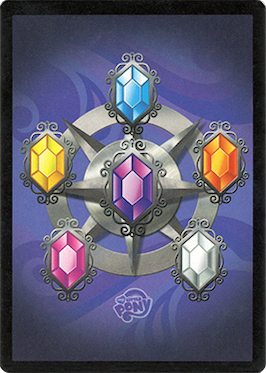
The My Little Pony Collectible Card Game is a two-player collectible card game based on the animated television series My Little Pony: Friendship Is Magic. It is produced by Enterplay LLC under license from Hasbro, and follows from Enterplay's previous work to produce a trading card series based on the same show.
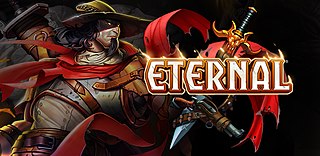
Eternal is a free-to-play online collectible card video game developed and published by Dire Wolf Digital. Eternal is available for iOS, Android, Xbox One, PCs using Steam and Nintendo Switch. The game features cross-platform play, allowing players to use any of the supported platforms to compete against each other. The game takes place in a Weird West fantasy setting. The game was in Steam early access in November 2016 and then had its official wide release in November 2018 that included support for the Xbox One. Eternal was released for the Switch on October 8, 2019.
A digital collectible card game (DCCG) or online collectible card game (OCCG) is a computer or video game that emulates collectible card games (CCG) and is typically played online or occasionally as a standalone video game. Many DCCGs are types of digital tabletop games and follow traditional card game-style rules, while some DCCGs use alternatives for cards and gameboards, such as icons, dice and avatars. Originally, DCCGs started out as replications of a CCG's physical counterpart, but many DCCGs have foregone a physical version and exclusively release as a video game, such as with Hearthstone.
















